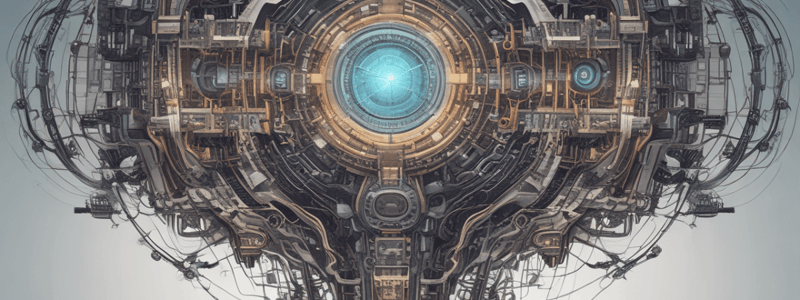Podcast
Questions and Answers
What is the primary focus of non-functional requirements in software systems?
What is the primary focus of non-functional requirements in software systems?
- Specific functions and features
- Technical design aspects
- User tasks and workflows
- Characteristics essential for effective operation (correct)
During the inception phase, which type of requirement is specifically targeted at detailing the technical design of the software system?
During the inception phase, which type of requirement is specifically targeted at detailing the technical design of the software system?
- User requirements
- Domain requirements
- System requirements
- Design requirements (correct)
In Object-Oriented Analysis and Design (OOAD), what is the primary purpose of a use case?
In Object-Oriented Analysis and Design (OOAD), what is the primary purpose of a use case?
- Describe the actors involved in the software development process
- Demonstrate the architectural design of the software system
- Represent a sequence of actions the system performs in response to an external event (correct)
- Show how users interact with the system to solve a problem
Which category of requirements typically includes information about operating systems and network protocols?
Which category of requirements typically includes information about operating systems and network protocols?
What is the primary objective of the Use-Case Model during the inception phase?
What is the primary objective of the Use-Case Model during the inception phase?
What is the main objective of the inception phase in Object-Oriented Analysis and Design?
What is the main objective of the inception phase in Object-Oriented Analysis and Design?
Which element of the Use Case Model defines how actors use a system to accomplish a specific objective?
Which element of the Use Case Model defines how actors use a system to accomplish a specific objective?
How are swimlanes used in activity diagrams?
How are swimlanes used in activity diagrams?
What does a merge node represent in an activity diagram?
What does a merge node represent in an activity diagram?
What is one of the activities carried out during the inception phase to establish the common vision for a project?
What is one of the activities carried out during the inception phase to establish the common vision for a project?
How are flow final nodes represented in an activity diagram?
How are flow final nodes represented in an activity diagram?
What does 'Defining the scope' involve in the inception phase of Object-Oriented Analysis and Design?
What does 'Defining the scope' involve in the inception phase of Object-Oriented Analysis and Design?
During the inception phase of OOAD, what does the project team do in the 'Identifying stakeholders' activity?
During the inception phase of OOAD, what does the project team do in the 'Identifying stakeholders' activity?
In an activity diagram, how are object nodes depicted?
In an activity diagram, how are object nodes depicted?
What is the purpose of a fork node in an activity diagram?
What is the purpose of a fork node in an activity diagram?
How are synchronization points represented in an activity diagram?
How are synchronization points represented in an activity diagram?
What does a join node do in an activity diagram?
What does a join node do in an activity diagram?
How are object nodes depicted in an activity diagram?
How are object nodes depicted in an activity diagram?
Which element in an activity diagram indicates the end of a flow?
Which element in an activity diagram indicates the end of a flow?
What is the function of a merge node in an activity diagram?
What is the function of a merge node in an activity diagram?
In an activity diagram, what is the purpose of swimlanes?
In an activity diagram, what is the purpose of swimlanes?
Flashcards are hidden until you start studying
Study Notes
Here are the study notes in bullet points:
Non-Functional Requirements of a Software System
- Non-functional requirements focus on the technical design of the software system.
- Examples: operating systems, network protocols.
Use Cases and Actors
- Use cases represent a sequence of actions that the system performs in response to an external event to achieve a specific goal or objective.
- Actors are people, organizations, or systems that interact with the software system being developed.
- There are three types of actors: primary actors, supporting actors, and offstage actors.
Use Case Model
- The use-case model is a model that shows how users interact with the system to solve a problem.
- The use-case model defines the user's objective, the interactions between the system and the user, and the system's behavior required to meet these objectives.
Use Case Diagram
- A use case diagram is a graphical representation of the relationships between actors and use cases.
- Components of a use case diagram include actors, use cases, and associations between them.
Inception Phase of Object-Oriented Analysis and Design (OOAD)
- The inception phase involves gathering information and understanding the requirements for a new software project.
- Activities in the inception phase include:
- Identifying the problem to be solved
- Defining the scope of the project
- Identifying stakeholders
- Establishing project goals and objectives
- Creating the initial set of requirements
Artifacts in Inception
- Artifacts in inception include:
- Vision and Business Case
- Use-Case Model
- Supplementary Specification
- Glossary
- Risk List and Risk Management Plan
- Prototypes and proof-of-concepts
- Iteration Plan
- Phase Plan and Software Development Plan
- Development Case
Requirements
- Requirements are high-level descriptions of a particular system service, constraint, or detailed specification generated during the requirements gathering process.
- Types of requirements include:
- Functional requirements
- Non-functional requirements
- User requirements
- System requirements
- Design requirements
- Domain requirements
Studying That Suits You
Use AI to generate personalized quizzes and flashcards to suit your learning preferences.





